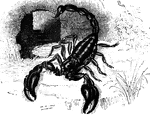
Cumming's Phleomys
"Found on the Island of Lucon. It is a rare species, even in its native island, and its habits are little…

Long Tailed Field Mouse
"It being four to five inches long, the tail nearly the length of the body. Its color is a yellowish-fawn…

Pithecheirus Melanurus
"This includes one animal, the P. melanurus, which has puzzled the naturalists, inasmuch as…

Giant Tatou
"In this carapace covers the body above and low down on the sides, but leaves the belly unprotected;…

Aardvark
"It is about three and a half feet long, the tail one foot nine inches. It has a long callous snout…

Indian Pangolin
"Its head is small, pointed, and conic; muzzle elongated and narrow; body rather stout; tail short and…

Yak
"The color of this animal in the wild and take, is black; the back and tail often white; the hair is…

Jersey Cattle
"The Jersey cattle has a small deer-like head, muzzle fine and dark and encircled by a light color,…
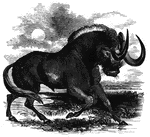
Gnu
"The Gnu has a formidable pair of horns, leading first downward and then pulling upward, and has been…

Savannah Flycatcher
Found in the southern United States, the Savannah fly-catcher is notable for its long, forked tail.

Tricolored Alectrurus
Native to South America, the tricolored alectrurus measures only six inches in length.

Gemsbok
"It is a heavy stout animal, about five feet in length, and three feet two inches high at the shoulder;…

Long-Tailed Titmouse
The most noted of the titmice, the long-tailed titmouse is about five and a half inches in length, half…

Widowbird
The widowbird, also known as the whidahfinch. Although most specimens are about the size of a canary,…
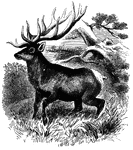
American Elk
"is a large and noble species, resembling the red deer of europe; is has tall, round, branching horns,…
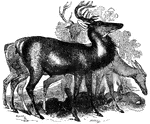
Male American Deer
"It is about the size of the European fallow-deer, and resmebles it in temper and character; the color…

Female American Deer
"It is about the size of the European fallow-deer, and resmebles it in temper and character; the color…

Mule Deer
"Is between the common deer and the American elk in size. Its horns are round and twice forked; the…

Napu Musk Deer
"Is two feet long and nine inches high; the eyes large and brilliant; the tail short; the general color…

Quagga
"Its general color is brown, the head, neck, and withers striped or zebraed wth blackish-brown; the…

Dauw
"Is of a pale brown color; the underside of the body being whitish; head, body, and upper part of the…

Guinea Hog
"It is of the size of a common hog; has long, narrow, straight ears, with a pencil of hair at the tips.…

Spotted Martin
"Is eighteen inches long, with a tail nearly as long as the body; its fur is chestnut-color, spotted…

Long Nosed Bandicoot
"Having a long head, with the upper part of the snout much prolonged: the tail is long and tapering;…

Common Opossum
"It has a pointed head, wide gape, numerous sharp teeth, a rough tounge, ears large and naked, small…

Sugar Squirrel
"It is about as large as our red squirrel; the tail rather longer than the body; the fur soft and beautiful;…

Wombat
"A short-legged, thickset animal, the body two feet long, the tail half an inch long. It lives in burrows…

Rostrated Tarsipede
"A small, pretty, mouse-like animal, about three inches long, having a rostrated or beak-shaped snout,…
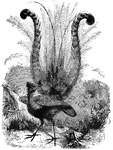
Lyre Bird
Also known as the Superb Menura, the lyre bird is noted for its distinctive tail feathers. The male…

Pintail Duck
The pintail duck measures twenty-six to twenty-eight inches in length (including the tail), and is found…

Mandarin Duck
The Mandarin duck, also known as the Chinese teal and the fan-tail duck, is domesticated in China and…

Long-Tailed Duck
Also known as the old-wife, the long-tailed duck measures about seventeen inches, not including its…

Tropicbird
Notable for its lengthy tail-feathers, the tropic bird inhabits the tropical regions of the Atlantic…

Herpeton tentaculatus
"The muzzle of H. tentaculatus is furnished with two soft prominences, covered with scales, the use…

Frog with tail
Nearing the end of its development, a gradually shrinking tail is all that remains of the tadpole.

Order of the Cincinnati
"Order of the Cincinnati. This was drawn from an original in the possession of Edward Phalon, Esq.,…

Common warty-newt
The common warty-newt of Europe... is six inches long, and is common in large ponds and ditches, where…

Shark
"Theses are at once distinguished by their elongated, spindle-shaped bodies, their branchial apertures…

Thresher Shark
"Is twelve to eighteen feet long, the tail nearly as long as the body; it uses this member for attacking…

Bordered Ray
"Is two to three feet long, including the tail. The flesh is tolerably food, common on European coasts"…

Sting Ray
"Its tail is arme with a sharp spine fives inches long, serated on both edges, with which it lacerates…

Seahorse
"These animals have a head of the shape of a horse, and a long tail without any fin, but which is used…

Fifteen-Spined Stickleback
"Five to eight inches long. It is very voracious, and one six inches long being put into a pail of water…

Hooked squid
"Its length from tail to the end of the tentacles is six feet. The two largest of these are furnished…

Acanthoclinus
"(A fish that) had a compressed claviform body, posterior dorsal fins nearly opposite to the anus, prolonged…

Acanthophis
"A genus of venomous serpents, they are of small size, live on dry land, and feed upon frogs, lizards,…

Aardvark
"Aard-vark is a burrowing insect-eating animal of the order Edentata found in South Africa. The name…
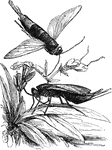
Sawfly
"On the continent of Europe the Sirex gigas often appears in immense numbers, and does great…

Troilus Butterfly
"The Troilus Butterfly, Papilio Troilus, is a superb insect, the wings denticulated, black,…

Chrysalis of the Luna Moth
"Among the larger and more splendid moths of our own country is the Luna Moth, or Green Emperor Moth,…

Luna Moth
"Among the larger and more splendid moths of our own country is the Luna Moth, or Green Emperor Moth,…

Caterpillar of the Luna Moth
"Among the larger and more splendid moths of our own country is the Luna Moth, or Green Emperor Moth,…

Aye-Aye
"The Aye-aye is an animal of Madagascar, so called from its cry, now referred to the lemur family. It…
!["[The paguridae] includes the Hermit or Soldier Crab, <em>Pagurus Bernardus</em>, the abdominal portion of whose body is quite soft, forming a sort of cylindrical fleshy mass behind the shelly cephalothorax. As the comfort of the animal would be materially interfered with were this soft, worm-like appendage exposed to be grabbed at by every passing fish who might take a fancy to it, he usually seeks some shelter for its tail, and the habitation selected is generally the empty shell of some univalve mollusk." — Goodrich, 1859](https://etc.usf.edu/clipart/14900/14983/hermit-crab_14983_mth.gif)
Hermit-crab
"[The paguridae] includes the Hermit or Soldier Crab, Pagurus Bernardus, the abdominal portion…

Earth-worms
"The bodies of these animals are of a cylindrical form, somewhat pointed at the anterior extremity,…

Common Creeper
"Creepers are a family of birds which strongly resemble the woodpeckers in their habit of creeping on…

Erne
"The Erne is one of the 'bare-legged' eagles. The genus includes some seven species, represented apparently…


